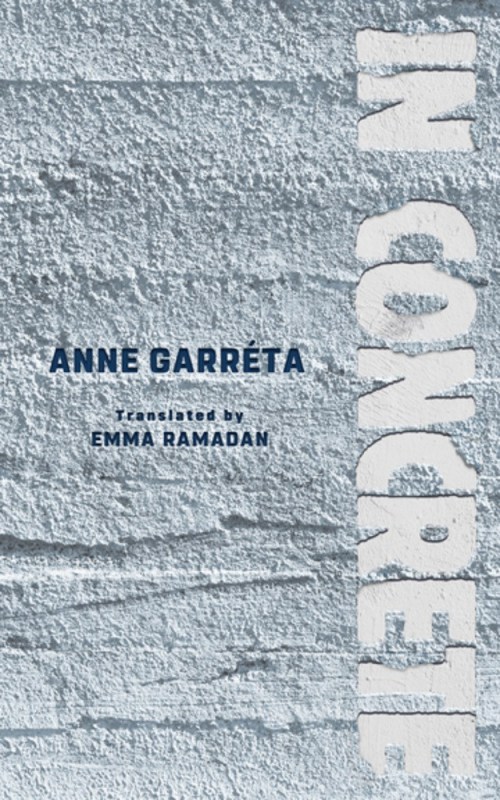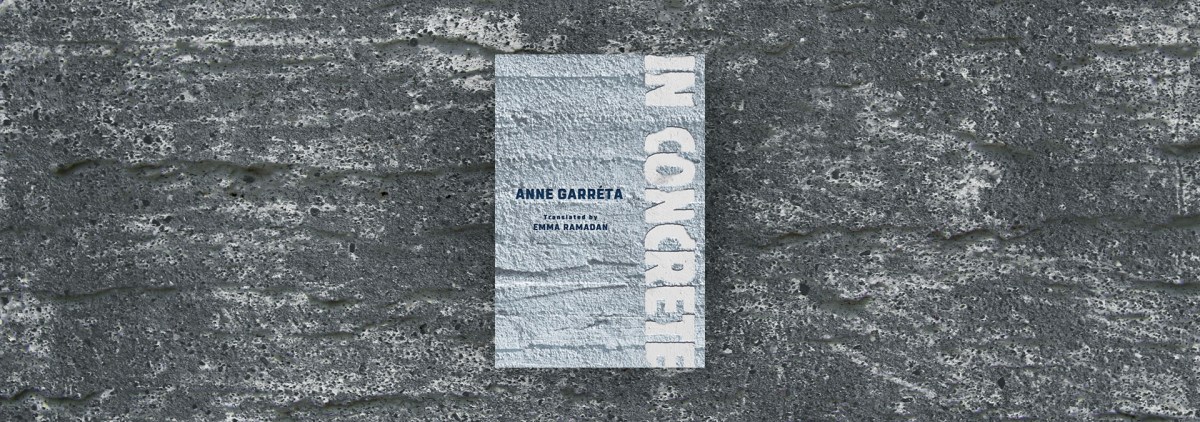[ad_1]
Occasionally a novel comes along that stretches the formal limits of language on the page. A novel that bends the rules, that glides past the barriers that we had assumed were unassailable, firmly entrenched around our preconceived notions of fiction and form. It’s somehow odd that we are surprised each time this occurs, as if art wasn’t meant to redefine the assumptions and habits we hold. In the case of In Concrete, Anne F. Garréta’s new novel in English, translated from the French by Emma Ramadan, the line between written and spoken language deteriorates to the point of nonexistence, the two modes of communication flowing freely between each other throughout the novel.
The story centers around a family and the father’s love of modernization (or “muddernization,” as the 12-year-old who narrates the book would put it) which comes to a zenith of potential mayhem when he acquires a concrete mixer and starts attempted improvements of every face of their home. After an explosion in the mixer, the narrator (who introduces themselves as: “Fignole, that’s my nickname. Fignole, Finiole, or Fignol. Like Guignol and his band. Not a bad nickname for someone who likes to finagle. It’s a little tease that even skitters sometimes into Feignole”) thinks (and dictates):
“It was as though a tremor shook the place, even more than a tremor, more than an explosion, more like a colossal toppling of everything – period. The walls teetered – semicolon; as though the hovel were pulling off its foundations to prance about – line break.”
Garréta is the only female member of the French Oulipo group, or “workshop of potential literature”, which is marked by a use of constraints in writing, the most notable being Georges Perec’s novel, written without the letter “e”. Garréta’s first novel translated into English, Sphinx, does without gender for the main characters, as the love interest of the narrator is only referred to as A***. In her second novel, Not One Day, the constraint is explained at the beginning as five hours of scheduled daily writing about a woman she has desired or has been desired by, but the constraint falls apart, which is revealed at the end of the book.
In Concrete is Garréta’s first novel in a decade, and is far different in scope and theme than the previous two. Both of her first two novels to be translated into English were preoccupied with the nature of desire, and how that can be expressed through the body, through the nuance of movement and assumptions. This new work takes a new path, one that mines the experience of obsession and family, of entropy, and the ceaseless flow of time.
Early on in the novel, Fignole’s sister, Angélique (though she is called Poulette throughout), falls into the concrete mixer after a mishap with the machinery. This main plotline of the book is constantly digressed away from by Garréta, using it as a means to explain the background of the rest of the family, as well as the distinction between the ways in which children spend their time when they are with their parents and without. Through the child’s perspective, Garréta drives the story with a nursery rhyme-like tenor. Fignole speaks intellectually and far past her age while also simultaneously retelling the story of her and her sister’s exploits in the neighborhood, fighting and waging so-called “wars” against the kids and students that were around.
At one point, Fignole tries to explain entropy, and in a way describes what Garréta has done with the book at large; she’s written an entropic novel that at all times resists the urge to be orderly, to abide by the main plot points, to be easily read and consumed. The novel is many things all at once: a childhood story of passing the summer days, a family saga of different wants and needs, an Oulipian fairytale, a multigenerational satirical look at what modernization means in the city versus the countryside. The novel is many stories, and entropy is many things in this story:
“Entropy goes hand in hand with klutziness, like the chicken and the egg and vice versa. Like Moses and Pharaoh’s daughter. Like syphilis and parish priests. Like manna and the desert.”
Or:
“Entropy is the quagmire of empire, when you can no longer escape, empirically in situ.”
Or even:
“Entropy is simple, says Poulette; entropy is our father.”
After the explosion in the concrete mixer, which leads to Poulette being covered in concrete, encased in a sarcophagus until she can be freed, tales are told of the two children’s journeys into the city for school, of hoarding weapons to joust and fight other kids with, or other barns and buildings their father has attempted to rebuild, or stories of defending kids from bullying.
“Angélique and I never tire of bitch-slapping the bourgeois. It’s a sport more fun and more honorable than bitch-slapping sissies. Besides, sissies aren’t always what you think. (The bourgeois, on the other hand, are always what you think.) Max, for example, the little sissy that we saved, who never left our side after that, Max was snot such a sissy after all.”
Mixed together with these asides are childhood renderings of words Fignole has heard though never seen written, in effect a representation of the way the book itself is written: Fignole understands how to tell the story orally, but is in over their head when writing it out. For example, Emma Ramadan writes in the translator’s note at the end of the book:
“I also relied heavily on linguistic blurriness, like the sliding from concrete to ‘crete to up shit’s ‘crete, from the sticks to the Styx, or the gray area between what a kid might hear and what they might think they hear, such as words like ‘muddernization,’ ‘electrifried,’ ‘bequeef,’ ‘scatastrophe,’ and so on and so fork.”
Garréta’s novel truly shines when the entropic nature is subjected to magnification towards the end of the work, as a means to explore how the decisions and nondecisions, rushed choices and cut corners, can misconstrue one’s view of the current of time. At one point, Fignole is reminiscing about an old lady their grandpa has known since grade school:
“For a long time I dream of plunging headfirst against the current of time, turning back its course to the moment I could have known that exquisite little girl and her black-currant syrup, and also, with a bit of luck, I could have known my beloved grandma…”
These wishes and hopes spoken from that of a 12-year old tinge them with a childlike sense of naiveté, though these are universal desires, a feeling that as always, Garréta writes about brilliantly. After freeing Poulette from her casing of concrete, the family slows down on their muddernizations, taking a step back from the reckless push for progress that had defined their existence up till now.
“But it’s not just the fear of time that runs through you, that carries and displaces you and leads you astray. The world engulfs you too.”
The crystallization of this, the realization of the power of time and the acknowledgement from the child’s point of view of the limitations on modernization and, in this case, concrete, provide the ending that this entropic novel seemed destined to not find, and places Garréta as a distinctly talented writer of fiction, unlike anything else right now.

FICTION
In Concrete
by Anne F. Garréta
Deep Vellum Publishing
Published May 11th, 2021
[ad_2]
Source link
